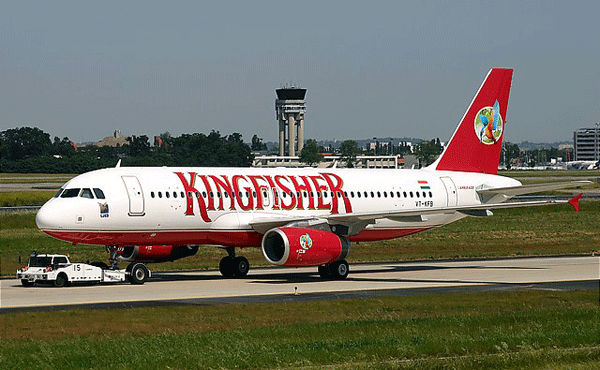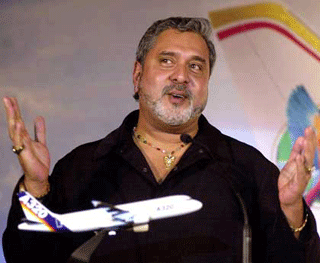Here
Comes Kingfisher Cargo

(Exclusive Interview Part Two: Conclusion)
Lack of infrastructure at some of India’s
premier gateways notwithstanding, Dr Vijay Mallya’s Kingfisher Airlines
is getting ready to enter the air cargo business.
The phenomenal growth in airfreight services
to and from India has been attracting new and existing airlines.
This, despite the fact that inadequate airport
infrastructure continues to be a major hurdle that is choking the growth
in air cargo traffic.
 The
latest to join the queue is Kingfisher Airlines, Brainchild of Dr Vijay
Mallya, The
latest to join the queue is Kingfisher Airlines, Brainchild of Dr Vijay
Mallya,
Kingfisher’s Cargo Carriers, will
be flying a different route.
The business model that the Kingfisher chief
has drawn up, takes into account the country’s tremendous production
advantages in agriculture.
“With our strong base in agriculture,
the country has a large and varied raw material supply for the food processing
industry.”
Incidentally India is the third largest
producer of food in the world including production of more than 91 million
tons of milk (the highest in the world), 150 million tons of fruits and
vegetables (the second largest), 485 million livestock (largest), 212
million tons of food grain (third largest) and also high volumes of eggs,
poultry and fish.
Processing levels, however, are very low.
Conservative estimates put processing levels in the fruits and vegetables
sector at 2 percent, poultry 6 percent, milk 35 percent, marine products
8 percent, etc.
The agro and food sector faces several other
challenges.
Long and fragmented supply chains are viewed
as being the single largest bottleneck.
Supply chain constraints together with demand-related
issues have cumulatively chalked up inefficiencies.
Further, inadequate storage has led to unacceptable
levels of waste and value loss.
“Kingfisher has decided to go for
cargo.”
The airline will certainly look at acquiring
a couple of freighters.
As the Kingfisher chief put it:
“We will not be putting in a couple
of aircraft just to fly them all around the country either. “Kingfisher
is looking at total logistics
management.
“Simply put, Kingfisher’s cargo
operations will be kept completely separate from its passenger operations.”
The fleet, Mr. Mallya envisages, would consist
of STOL aircraft (short take off and landing). These planes would be able
to land or take off from dirt runways and fly into the hinterland.
Dr Mallya has plans for these carriers to
pick up cargo, fruits, vegetables and flowers and fly them to an intermediary
cold storage from where they would then be flown out of the country. Citing
the instance of flowers, he said, India could look forward to exports.
“India exports massive amounts of
flowers. Just the other day a whole jumbo jet of flowers departed Bangalore
for Amsterdam. Obviously, there is very good scope for agricultural produce.”
As for domestic consumption, Kingfisher
would fly cargo to hyper-markets and cater to their special, just in time
and seasonal needs.
The handwriting for air cargo is on the wall.
Soon it will not just be national carriers,
Indian (Airlines) and Air India that populate future skies with freighters.
New entrants GoAir has chalked out plans
to play a bigger role in the airfreight market as well.
Air cargo has risen steadily risen from
4.16 lakh tons in 1998-99 to 4.91 lakh tons in 2000-01, 5.84 lakh tons
in 2003-04 and over 6.20 lakh tons in the last fiscal year.
The high growth rate is the prime reason
that aircraft manufacturers Boeing and Airbus have been targeting India
looking for sales. Boeing, in fact, had estimated that India’s domestic
air cargo market could go up to more than 2.25 lakh tons in 2006 alone.
A recent study by Drewry and APL Logistics
has revealed that India's air cargo traffic could be reasonably expected
to register annual gains in the 8 to 10 percent range over the next five
to 10 years.
That prospect is certainly music for airline
service providers.
The other and perhaps, more important plan
that Dr Vijay Mallya has chalked out is enhancement of secondary routes,
setting aside for the moment challenges at the major metro gateways in
the country, given the fact that they face major infrastructure problems.
In plain speaking “when it comes to
infrastructure India still has a long way to go”.
Take the case of Pune, for example.
The Pune airport with its international
stature has yet to market its ability to handle air cargo, nearly three
months after international flights have commenced from there.
More than 80,0000 tons of cargo, accounting
for nearly a third of the cargo cleared presently from Mumbai’s
Sahara Air Cargo, is produced at Pune.
The airport has a Customs facility.
A number of heavy engineering, light engineering
and food processing items could be sent from Pune cargo terminal, but
the industry has yet to avail itself of that opportunity.
Dr Mallya said:
“The opportunities in the country
are humongous.
“All that is needed is a clear focus
and the will to move ahead.”
(Tirthankar Ghosh)
|



